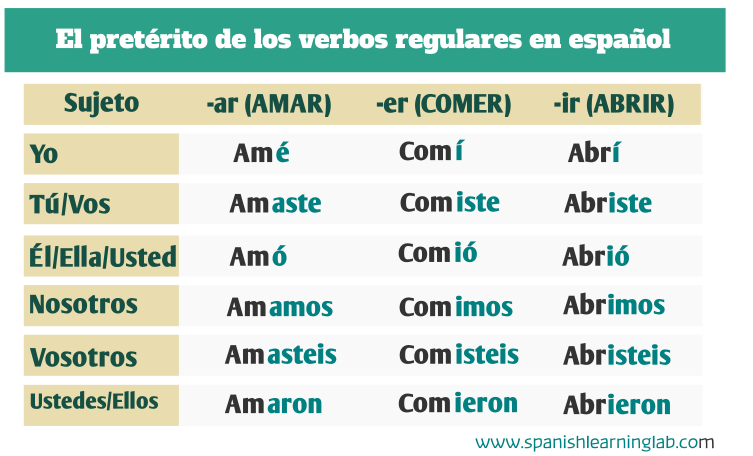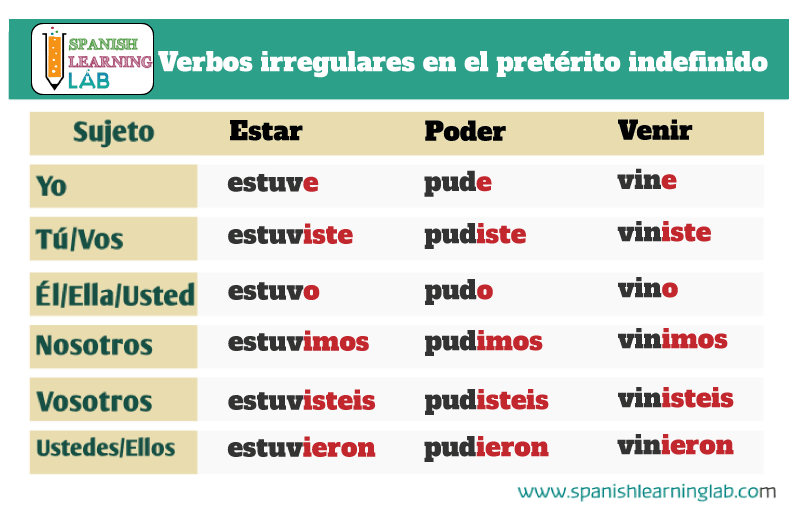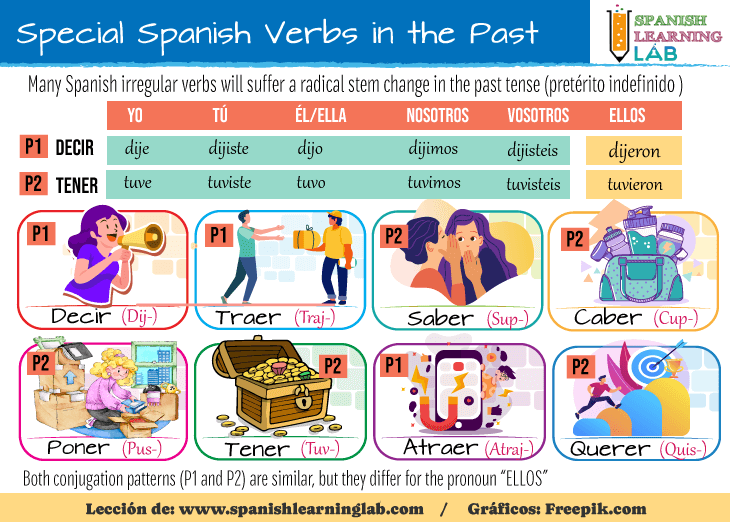In everyday interactions, it is very common to find ourselves talking about past events in Spanish, things that happened recently or a long time ago. In this lesson, we will learn the basic rules to conjugate both regular and irregular verbs in the preterit tense in Spanish properly. As usual, you will find simple explanations, many examples of sentences and interactive quizzes to test yourself. Let’s start…
The past tense of regular verbs in Spanish
We can refer to the past tense in Spanish as: “El pretérito perfecto simple”, “El pretérito indefinido” or simply as “El pasado simple”. Just like in English, the preterite or past tense will be used for actions that happened at some time in the past and have already finished. Spanish verbs in past tense will change just the same way verbs in the present tense do, depending on the subject of the sentence. Know that you will also find irregular verbs in the past tense.
As you can see in the chart below, the stem of regular verbs in the past tense in Spanish will not change at all for most verbs, only their ending.

Keep two things in mind; first, the endings used for –ER and –IR verbs like COMER and ABRIR are identical, and second, the conjugations for the pronouns YO, ÉL, ELLA and USTED in the preterite tense will always need a tilde over the last vowel for regular verbs. Following the chart above, we just need to know which verbs have regular conjugations in the preterite in Spanish, some of them being: cenar, caminar, trabajar, mirar, comer, correr, vivir, escribir, descansar, levantarse, salir, responder.
Examples with -AR regular verbs in the past tense
- Yo cené con mis amigos en ese restaurante. (I had dinner with my friends at that restaurant.)
- María habló con sus padres sobre sus planes. (Maria talked to her parents about her plans.)
- Vosotros olvidasteis felicitarme por mi cumpleaños. (You forgot to congratulate me on my birthday.)
Examples with -ER and -IR regular verbs in the past tense
- Tú aprendiste español porque te esforzaste. (You learned Spanish because you worked hard)
- Nosotros abrimos la tienda a las 8:00 am ayer. (We opened the store at 8:00 am yesterday.)
- Ellos bebieron demasiado vino. (They drank too much wine.)
Just like in the English language, there are specific past time expressions in Spanish that help us to add information about the time an event happened, such as: ayer (yesterday), anteayer/antier (the day before yesterday), anoche (last night), el otro día (the other day), hace un año (a year ago) and so on. Pay attention to the next group of sentences using some verbs with regular past tenses in Spanish and some of these expressions:
|
CAMINAR – Ayer caminé 4 kilómetros alrededor de la ciudad
WALK – Yesterday I walked 4 kilometers around the city
|
|
SALIR – Marcelo salió anteayer hacia Europa.
LEAVE – Marcelo left the day before yesterday for Europe.
|
|
CORRER – ¿Tú también corriste en el maratón que organizaron recientemente?
RUN – Did you also run in the marathon they recently organized?
|
|
VIVIR – Nosotros vivimos en esa casa por tres años. Nos mudamos el año pasado.
LIVE – We lived in that house for three years. We moved last year.
|
|
LEVANTARSE – Ellos se levantaron temprano porque el bus sale a las 6:00 am.
GET UP – They got up early because the bus leaves at 6:00 am.
|
Interactive quiz
Drag and drop the different past tense conjugations of the verbs HABLAR, BEBER and VIVIR to the correct areas.
Recognizing irregular preterite verbs in Spanish
A lot of the verbs that are considered irregular in the present tense will also be considered irregular in the past tense in Spanish, including verbs such as: “caber”(to fit), “dar”(to give), “poder” (be able to), “saber” (know) and others.
Verbs with irregular stems and endings in the preterite tense
There is a particular group of verbs that are commonly used in the language, but they suffer stem changes as well as changes in their ending, that is, they won’t follow the rules presented above. For this group of verbs, first you must memorize their stem in the past, e.g. “estuv-” for the verb ESTAR, and then remember the new endings that may apply only to them and a few other verbs. Take a look at the following chart and notice that the endings are different to those of regular verbs, but they stay the same for this unique group of irregular verbs:

Other irregular preterite verbs in Spanish following the pattern above, with a possible variation for “ELLOS”, are: “andar (anduv-), caber (cup-), decir(dij-), haber (hub-), poner (pus-), querer (quis-), saber (sup-), tener (tuv-)”. The following picture explains how we must change the verb’s stem and follow two different patterns (P1 and P2) depending on the new stem:

- Pattern No. 1: Carlos trajo a sus primos a la fiesta. (Carlos brought his cousins to the party.)
- Pattern No. 2: Nosotros pusimos la casa en venta. (We put the house up for sale.)
Listen to and analyze the next group of verbs and their conjugations in the past.
|
DECIR: Yo dije, Tú dijiste, Él dijo, Nosotros dijimos, Vosotros dijisteis, Ellos dijeron.
|
|
ESTAR: Yo estuve, Tú estuviste, Él estuvo, Nosotros estuvimos, Vosotros estuvisteis, Ellos estuvieron.
|
|
HACER: Yo hice, tú hiciste, él hizo, nosotros hicimos, vosotros hicisteis, ellos hicieron.
|
|
SABER: Yo supe, tú supiste, él supo, nosotros supimos, ellos supieron.
|
|
TENER: Yo tuve, tú tuviste, él tuvo, nosotros tuvimos, vosotros tuvisteis, ellos tuvieron.
|
Identical conjugations for SER and IR
Both the verbs SER and IR will change radically in the preterite form as well, but their conjugations in the preterite will be identical. For these two verbs, context plays a very important role when using them in real conversations.
|
IR: Yo fui, tú fuiste, él fue, nosotros fuimos, vosotros fuisteis, ellos fueron.
|
|
SER: Yo fui, tú fuiste, él fue, nosotros fuimos, vosotros fuisteis, ellos fueron.
|
- Ella fue a Italia el año pasado con su familia. (She went to Italy last year with her family.)
- Ella fue mi compañera de clases en primaria. (She was my classmate in primary school.)
Other special cases in the preterite in Spanish
There are many other irregular verbs and special cases in the past tense in Spanish besides the ones we have discussed so far, for instance:
Verbs with two vowels in their ending
Verbs like “leer, oír, concluir, incluir, constituir, construir, disminuir, fluir, poseer, caer, huir” suffer a spelling change for the pronouns YO, ÉL and ELLOS. For the pronoun “YO”, the -IR part will be replaced by “Í” with tilde as in “Yo concluí”; and for “ÉL” and “ELLOS”, we will add the consonant “y”.
- LEER: Yo leí ese libro en la escuela. (I read that book at school.)
- CONSTRUIR: Él construyó una mansión. (He built a mansion.)
- CAER: Dos árboles cayeron sobre la carretera. (Two trees fell on the road.)
Verbs ending in -GAR
When verbs end in -GAR in their infinitive form just like: “abrigar, agregar, ahogar, albergar, apagar, colgar”, the verb will be conjugated differently for the first person (the pronoun YO), so we will replace -GAR for -GUÉ as in these sentences:
- PAGAR: Yo pagué las cuentas (I paid the bills)
- COLGAR: Yo colgué la ropa (I hung the clothes)
Verbs ending in -CAR:
When verbs end in -CAR just like “buscar, dedicar, educar, enfocar, explicar, sacar, secar“, then we will replace -CAR for -QUÉ for the pronoun YO only, as in the sentences:
- BUSCAR: Yo busqué la billetera. (I looked for the wallet.)
- EXPLICAR: Yo expliqué ese tema hace un mes. (I explained that topic a month ago.)
Verbs ending in -DUCIR
When a verb ends in -DUCIR just like “traducir, conducir, deducir“, then we will replace -DUCIR for -DUJ for all subject pronouns, and add the conjugations in the second picture presented above.
- TRADUCIR: Yo tradujé todos esos documentos. (I translated all those documents.)
- CONDUCIR: Vosotros condujisteis sin parar. (You guys drove non-stop.)
Talking about past events in Spanish – Los eventos del pasado
It is time to see both regular and irregular in the preterite tense in Spanish in use. We will be using some of the ones presented above and a few new ones. These sentences follow a very basic structure and will use a few useful connectors to link the ideas, and you will see some specific phrases used in the past tense in Spanish such as “ayer” (yesterday), “la semana pasada” (last week) and so on.
No. 1 – Una visita al zoológico
La semana pasada fuimos al zoológico. Vimos varios animales interesantes y aprendimos muchas cosas sobre ellos también. Cuando miramos al gorila, mi amigo trató de tomar una foto, pero el gorila se enojó. Luego, vimos a los leones. También tomamos fotos de los leones. Escuchamos las aves cantar y a los monos aullar. Para finalizar el paseo, miramos los pingüinos. Ellos nadaron muy cerca de nosotros.
No. 2. – Mi fin de semana
- Francisco: ¿Qué hiciste (tú) el fin de semana pasado?
- Jorge: Yo estudié todo el fin de semana. Hoy tenemos un examen. ¿Tú estudiaste?
- Francisco: Yo no estudié. Ayer fui de paseo con mi familia. Nosotros fuimos a la playa. Mi mamá nadó toda la mañana. Mis hermanos también nadaron bastante. Comí pescado. Estaba delicioso.
- Jorge: Vaya, tú disfrutaste mucho entonces. Yo salí a tomar un café con Carmen y miramos una película después de estudiar.
Related Spanish Worksheets:
- Common Irregular Verbs in Spanish – PDF Worksheet
- The Imperfect Tense in Spanish – PDF Worksheet
- The Preterite Tense in Spanish – PDF Worksheet
- Describing Historical Figures in Spanish – PDF Worksheet (Reading)
- Let’s talk about the past in Spanish – Conversation cards
